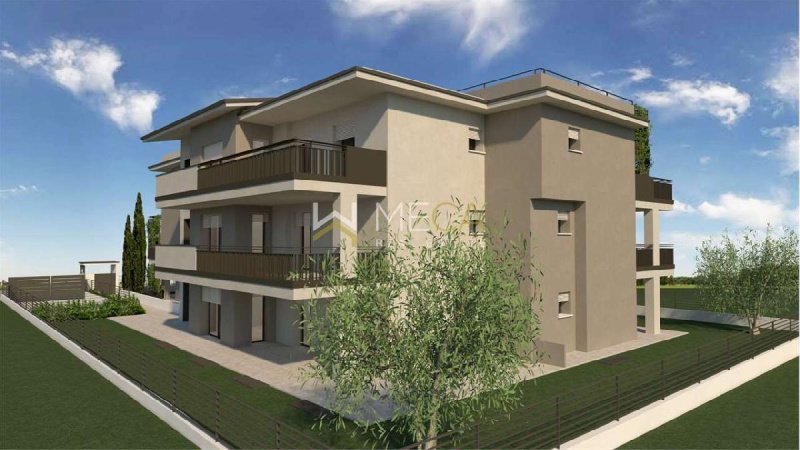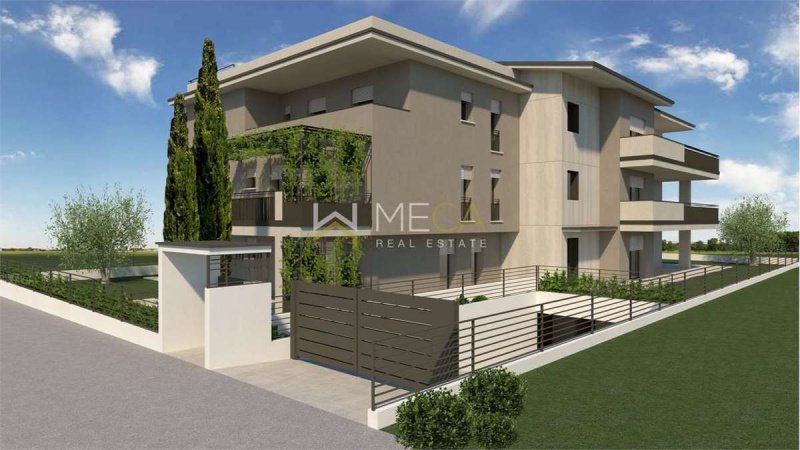Desenzano, right in the center, new three-room apartment on the first floor served by a lift.
Exceptional location in the center of Desenzano del Garda, 120 meters from the lake and with all public and commercial services easily reachable on foot.
Combined double garage, not included in the price, for EURO66,000.
The apartment is spread over a single floor and is composed of a spacious living area of over 30 sqm with open kitchen and access to a 32 sqm terrace; sleeping area with two bedrooms, one double and one twin.
Also available: first floor apartment with two bathrooms at the price of EURO629,000.
Photovoltaic system, heat pump, triple glazed windows, underfloor heating, air conditioning and alarm system.
Possibility to choose the finishes of your apartment (floors, doors, bathroom fixtures) through specifications with a wide choice of materials, such as "a tailored suit.
Lake Garda
Lake Garda or Benaco is the largest Italian lake, with a surface area of approximately 370 km² (third in depth after Como and Maggiore). Hinge between three regions, Lombardy (province of Brescia), Veneto (province of Verona), Trentino-Alto Adige (province of Trento), it is located parallel to the Adige, from which it is divided by the Monte Baldo massif. To the north it appears narrow like a funnel while to the south it widens, surrounded by moraine hills which make the landscape gentler. The lake is an important tourist destination and is visited by millions of people every year. In Roman times the lake was known as Benacus and was venerated by some as the god Benacus, the very personification of the lake, sometimes associated with the cult of the god Neptune. Today it is better known as Lake Garda, a toponym attested since the Middle Ages and of Germanic origin, deriving from that of the town of the same name on the Veronese side of the lake, which, together with another famous location on the lake, Gardone Riviera, and other less known, such as Gàrdola, Gardoncino, Gardoni, Guàrdola and Le Garde, testifies to the Germanic presence that goes from the 6th to the 8th century, in particular the Lombard one. The toponym Garda, with which the lake was already called in some documents from the 8th century, is the evolution of the Germanic word warda, meaning "place of guard" or "place of observation". The classic toponym of the lake, namely Benācus lacus (Benaco), is almost certainly of Celtic origin, therefore preceding Roman rule, and should derive from bennacus, comparable with the Irish bennach, and would mean "horned", or with many promontories. The translation "horned" is also interpreted in reference to the Sirmione peninsula. The Latin voice of Benaco is attested as Benācus, -i and therefore presupposes a plain accent (Benàco): the Italian version of the tonic accent remains faithful to the Latin accent, therefore it must be pronounced with the accent on the "a".
自动翻译所用的语言
Desenzano, pieno centro, nuovo trilocale al primo piano servito da ascensore.
Posizione eccezionale nel pieno centro di Desenzano del Garda, a 120 metri dal lago e con tutti i servizi pubblici e commerciali raggiungibili comodamente a piedi.
Abbinato garage doppio, non incluso nel prezzo, per 66.000 EURO.
L'appartamento si sviluppa su un singolo piano ed è composto da una spaziosa zona giorno di oltre 30 mq calpestabili con cucina a vista e accesso a terrazza di 32 mq; zona notte con due camere una matrimoniale e una doppia.
Disponibile anche appartamento al piano primo con due bagni al prezzo di 629.000 EURO.
Impianto fotovoltaico, tripli vetri, pompa di calore, riscaldamento a pavimento, predisposizione aria condizionata e impianto allarme.
Possibilità di scegliere le finiture del proprio appartamento (pavimenti, porte, sanitari) mediante un capitolato con ampia scelta di materiali , come "un abito sartoriale.
Il lago di Garda
Il lago di Garda o Benaco è il maggiore lago italiano, con una superficie di circa 370 km² (terzo per profondità dopo Como e Maggiore). Cerniera fra tre regioni, Lombardia (provincia di Brescia), Veneto (provincia di Verona), Trentino-Alto Adige (provincia di Trento), è posto in parallelo all'Adige, da cui è diviso dal massiccio del monte Baldo. A settentrione si presenta stretto a imbuto mentre a meridione si allarga, circondato da colline moreniche che rendono più dolce il paesaggio. Il lago è un'importante meta turistica ed è visitato ogni anno da milioni di persone. In epoca romana il lago era conosciuto come Benacus e da alcuni era venerato come dio Benacus, personificazione stessa del lago, talvolta associata al culto del dio Nettuno. Oggi è meglio noto come lago di Garda, toponimo attestato fin dal Medioevo e di origine germanica, derivante da quello dell'omonima cittadina sulla sponda veronese del lago, la quale, insieme a un'altra località celebre del lago, Gardone Riviera, e altre meno conosciute, come Gàrdola, Gardoncino, Gardoni, Guàrdola e Le Garde, testimonia la presenza germanica che va dal VI all'VIII secolo, in particolare quella longobarda. Il toponimo Garda, con il quale è chiamato il lago già in alcuni documenti dell'VIII secolo, è l'evoluzione della voce germanica warda, ovvero “luogo di guardia” o “luogo di osservazione”. Il toponimo classico del lago, ovvero Benācus lacus (Benaco), è quasi sicuramente di origine celtica, precedente quindi al dominio romano, e dovrebbe derivare da bennacus, confrontabile con l'irlandese bennach, e significherebbe “cornuto”, ovvero dai molti promontori. La traduzione “cornuto” viene anche interpretata in riferimento alla penisola di Sirmione. La voce latina di Benaco è attestata come Benācus, -i e presuppone quindi un accento piano (Benàco): la versione italiana dell'accento tonico rimane fedele all'accentazione latina, quindi va pronunciato con l'accento sulla “a”.
CLASSE ENERGETICA: A+
Desenzano, mitten im Zentrum, neue Dreizimmerwohnung im ersten Stock mit Aufzug.
Außergewöhnliche Lage im Zentrum von Desenzano del Garda, 120 Meter vom See entfernt und mit allen öffentlichen und kommerziellen Dienstleistungen bequem zu Fuß erreichbar.
Kombinierte Doppelgarage, nicht im Preis inbegriffen, für 66.000 EURO.
Die Wohnung erstreckt sich über eine einzige Etage und besteht aus einem geräumigen Wohnbereich von über 30 qm mit offener Küche und Zugang zu einer 32 qm großen Terrasse; Schlafbereich mit zwei Schlafzimmern, einem Doppel- und einem Zweibettzimmer.
Auch verfügbar: Wohnung im ersten Stock mit zwei Badezimmern zum Preis von 629.000 EURO.
Photovoltaikanlage, dreifach verglaste Fenster, Wärmepumpe, Fußbodenheizung, Klimaanlage und Alarmanlage.
Möglichkeit, die Oberflächen Ihrer Wohnung (Böden, Türen, Badezimmereinrichtungen) anhand von Spezifikationen mit einer großen Auswahl an Materialien wie „einen maßgeschneiderten Anzug“ auszuwählen.
Gardasee
Der Gardasee oder Benaco ist der größte italienische See mit einer Oberfläche von etwa 370 km² (der drittgrößte nach Como und Maggiore). Er ist Scharnier zwischen drei Regionen, Lombardei (Provinz Brescia), Venetien (Provinz Verona), Trentino-Südtirol (Provinz Trient) und liegt parallel zur Etsch, von der er durch das Monte-Baldo-Massiv getrennt ist. Im Norden erscheint er schmal wie ein Trichter, während er sich im Süden weitet und von Moränenhügeln umgeben ist, die die Landschaft sanfter machen. Der See ist ein wichtiges Touristenziel und wird jedes Jahr von Millionen von Menschen besucht. In der Römerzeit war der See als Benacus bekannt und wurde von einigen als der Gott Benacus verehrt, die Personifizierung des Sees selbst, die manchmal mit dem Kult des Gottes Neptun in Verbindung gebracht wird. Heute ist er besser bekannt als Gardasee, ein seit dem Mittelalter bezeugter Ortsname germanischen Ursprungs, der sich von dem der gleichnamigen Stadt auf der veronesischen Seite des Sees ableitet, die zusammen mit einem anderen berühmten Ort am See, Gardone Riviera, und anderen weniger bekannten Orten wie Gàrdola, Gardoncino, Gardoni, Guàrdola und Le Garde von der germanischen Präsenz vom 6. bis zum 8. Jahrhundert zeugt, insbesondere von der lombardischen. Der Ortsname Garda, mit dem der See bereits in einigen Dokumenten aus dem 8. Jahrhundert bezeichnet wurde, ist die Weiterentwicklung des germanischen Wortes warda, was „Wachort“ oder „Beobachtungsort“ bedeutet. Der klassische Ortsname des Sees, nämlich Benācus lacus (Benaco), ist mit ziemlicher Sicherheit keltischen Ursprungs und stammt daher aus der Zeit vor der römischen Herrschaft. Er sollte von bennacus abgeleitet sein, vergleichbar mit dem irischen bennach, und würde „gehörnt“ oder mit vielen Vorgebirgen bedeuten. Die Übersetzung „gehörnt“ wird auch in Bezug auf die Halbinsel Sirmione interpretiert. Die lateinische Aussprache von Benaco ist als Benācus, -i belegt und setzt daher einen einfachen Akzent (Benàco) voraus: Die italienische Version des Tonika-Akzents bleibt dem lateinischen Akzent treu, daher muss er mit der Betonung auf dem „a“ ausgesprochen werden.


